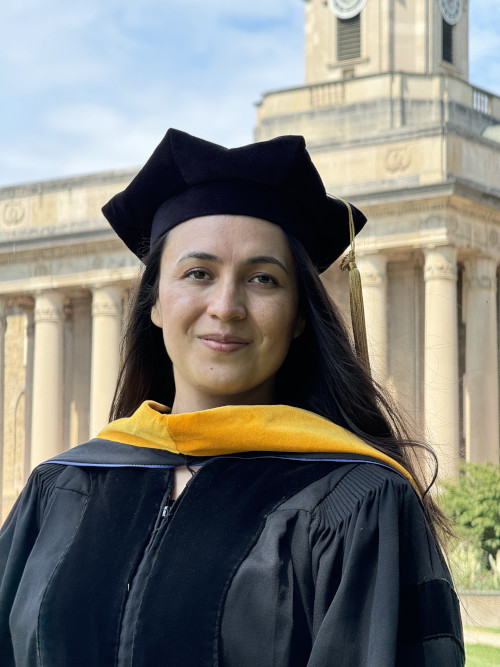Tracing the Origins of Rare Cosmic Explosions
2022-11-30
The galactic homes of 84 short gamma-ray bursts (sGRBs)—produced by the collision of two neutron stars—have now been pinpointed in what is the most extensive inventory to date. A team that includes astronomers from Penn State used information from several highly sensitive instruments at the W.M. Keck Observatory, Las Campanas Observatory, MMT Observatory, and Gemini Observatory, combined with some of the most sophisticated galaxy modeling ever used in the field to identify the sources of these sGRBs.
“At most, astronomers might detect about a dozen short gamma-ray bursts each year, and so far only one has a confirmed origin from a neutron star merger,” said Joel Leja, assistant professor of astronomy and astrophysics at Penn State and a member of the research team. “Their mysterious origins have led us to take a lateral approach by instead trying to understand the environments where these objects thrive. The resulting catalog greatly expands our knowledge of where sGRBs come from and will help astronomers determine their true origins.”
SGRBs are momentary flashes of intense gamma-ray light emitted when two neutron stars collide. As an homage to the fact that sGRBs are among the brightest explosions in the universe, the team calls their catalog BRIGHT (Broadband Repository for Investigating Gamma-ray burst Host Traits) with all of their data and modeling products online for community use.
“This is the largest catalog of sGRB host galaxies to ever exist, so we expect it to be the gold standard for many years to come,” said Anya Nugent, an astronomy graduate student at Northwestern University who led the research, observational efforts with Keck and the MMT observatories, and one of the two publications on the study.
While the gamma-rays from sGRBs last only seconds, the optical light that is also produced in the event can continue for hours before fading below detection thresholds, called an afterglow. SGRB afterglows were first discovered in 2005 by NASA’s Neil Gehrels Swift Observatory, whose mission operations center is located at Penn State. Since then, astronomers have spent the last 17 years trying to find out which galaxies these powerful bursts originated from, as the stars within a galaxy can give insight into the environmental conditions needed to produce these events and can connect them to their neutron star merger origins. The only sGRB with a confirmed neutron star merger origin, GRB 170817A, was detected just seconds after gravitational wave detectors observed the binary neutron star merger, GW170817.
“One way to better understand gamma ray bursts is to understand the types of ‘cosmic ecosystems’ which they tend to live in, meaning the gas and stars in the environment around them—their host galaxies,” said Leja. “We modeled the galaxies where these gamma-ray burst happened, including information about how many stars are in the galaxy, how it formed, how many heavy elements are there, and how much dust obscures our view of the galaxy. This allowed us to understand how galaxies where gamma-ray bursts explode are different than other galaxies.”
Learning about sGRB host galaxies is crucial to understanding the blasts themselves and offers clues about the types of stars that created them as well as their distance from Earth. Since neutron star mergers create heavy elements like gold and platinum, the data will also deepen scientists’ understanding of when precious metals were first created in the universe.
“Building this catalog and finally having enough host galaxies to see patterns and draw significant conclusions is exactly what the field needed to push our understanding of these fantastic events and what happens to stars after they die,” said Nugent.
“In a decade, the next generation of gravitational wave observatories will be able to detect neutron star mergers out to the same distances as we do sGRBs today. Thus, our catalog will serve as a benchmark for comparison to future detections of neutron star mergers,” added Wen-fai Fong, assistant professor of astronomy and physics at Northwestern University and lead author of one of the publications.
The first paper in the study
, published in The Astrophysical Journal, found that sGRBs occur at earlier times in the universe and at greater distances from their host galaxy’s centers than previously thought. Surprisingly, several of these explosions were found just outside their host galaxies as if they were “kicked out,” raising questions as to how they were able to travel that far.
Published in the same journal, the second research paper
in the study probed the characteristics of 69 of the identified sGRB host galaxies. The findings suggest about 85 percent of them are young, actively star-forming galaxies — a stark contrast to earlier studies that characterized the population of sGRB host galaxies as relatively old and approaching death. This means neutron star systems may form in a broad range of environments and many of them have quick formation-to-merger timescales.
Many questions remain about how neutron stars merge and how long the process takes. But observing sGRBs and their host galaxies provides one of the best perspectives to answer them and can offer more data about neutron star mergers and their hosts at much farther distances, and more frequently, than current gravitational wave detectors. This new sGRB host catalog will therefore serve as a vital reference point in the coming decade to understand the full evolution of these systems over cosmic time.
The James Webb Space Telescope (JWST) is poised to further advance our understanding of neutron star mergers and how far back in time they began, as it will be able to detect the faintest host galaxies that exist at very early times in the universe.
“This field is so young— there is so much more to learn,” said Leja. “We hope that we can learn even more about the cosmic environment of sGRBs with near-future observatories, and in this way better understand what precipitates these mysterious explosions.”
In addition to Leja, the research team at Penn State also includes Derek Fox, associate professor of astronomy and astrophysics.
Click here for the full article.
Additional links:







